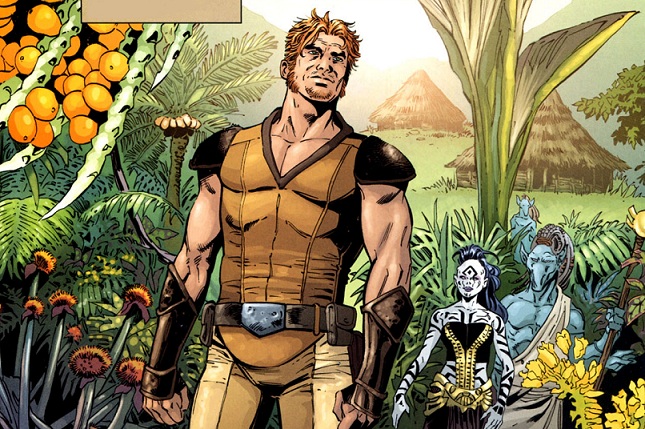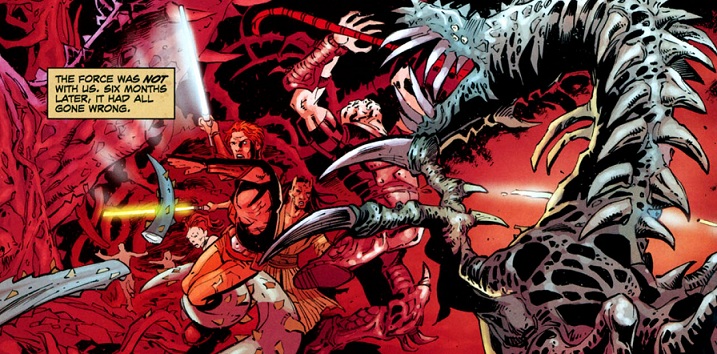The Ossus Project was a major project between the New Jedi Order and the Yuuzhan Vong. It coordinated from the planet Ossus, and overseen by Kol Skywalker and Nei Rin of the Shaper caste. The project's purpose was to heal and revive over a hundred worlds across the galaxy that had been devastated in the past, and some even hoped it would permanently end problems that had long afflicted the galaxy, such as hunger and war. It was sabotaged by Darth Maladi and Zenoc Quah to cause massive suffering, and the Council of Moffs framed the sabotage on the Yuuzhan Vong, creating a galaxy-spanning conflict that would become known as the Sith–Imperial War.

Kol Skywalker, Nei Rin, and Roax find success on Wayland.
The Galactic Alliance gradually finished rebuilding itself a few years later, but would never be the same as the pre-invasion New Republic. In 122 ABY, as part of a move to improve relations between the Yuuzhan Vong and the rest of the galaxy, the New Jedi Order permitted Yuuzhan Vong Shapers, under Master Shaper Nei Rin, to use a desolate part of Ossus, one of the Jedi Order's most ancient strongholds, as a testing area.
The intent of those who supported the project—such as Jedi Master Kol Skywalker, a leading member of the Jedi Council—was to see if Vong terraforming techniques, such as those that had once transformed Coruscant into the species's temporary homeworld of Yuuzhan'tar (27-29 ABY), could restore the world that had been left barren and devastated. The experiment appeared to work perfectly, returning Ossus to vibrant life again. When the Jedi showed the results to the outside galaxy, the response was tremendous as other worlds gained their chance to restore planets devastated by the Yuuzhan Vong War.
One hundred devastated planets were selected for potential terraforming. Yuuzhan Vong Shapers, overseen by Jedi escorts, set to work, and the initial results were wondrous to behold, exemplified on Wayland.
This success was short-lived, however. Agents from the One Sith, including Sith Lady Darth Maladi and Yuuzhan Vong shaper Zenoc Quah, secretly sabotaged the terraforming processes under the orders of the cult's leader Darth Krayt. Soon on Wayland, the vegetation of the terraformed world underwent mutations of a kind not seen since the Yuuzhan Vong forcibly took populations as slaves for shaping. Painful bony growths sprouted from the skin of the natives in a plague that affected all the terraformed worlds, bringing the project to a catastrophic end.

Things go wrong on Wayland.
The Yuuzhan Vong were shocked; none of the preliminary experiments on Ossus had shown any of the later mutations. Master Shaper Rin made it her mission to learn what had happened, and why. The Jedi suspected sabotage at once, but had no idea who was responsible. Many accused the Yuuzhan Vong as much animosity still existed towards the authors of one of the most destructive wars the Galaxy had ever seen. The Sith knew the lingering scars of the Yuuzhan Vong War would cause people to suspect them of such heinous acts. The Jedi, maintaining the innocence of the Yuuzhan Vong, convinced the Galactic Alliance to support the Yuuzhan Vong against bigotry and unbiased domestic criticism. This angered many Alliance worlds and as a result many withdrew from the Galactic Alliance or declared their neutrality.
The Empire meanwhile, seized on the opportunity opened by the loss of confidence in the Galactic Alliance. With the Pellaeon–Gavrisom Treaty that ended its war against the former Rebellion came in 19 ABY, the Imperial Remnant had ended its hostilities to New Republic as a neutral faction, and the Yuuzhan Vong invasion had brought them together as allies to the New Republic and its successor. But its nominal government, the members of the Moff Council, still had many hard-line holdovers to the old ways who wanted to restore the Empire to primacy as the dominant galactic power, peace treaty or not. Now they called for retribution and, invoking the Treaty of Anaxes, they declared war on the Galactic Alliance. The peace that so many had fought and died for in decades past was undone in one swift stroke, all thanks to the resurgent Sith Order.
Fearing what could ultimately happen, the Jedi High Council ordered the creation of the Hidden Temple at the start of hostilities, its location chosen by Nat Skywalker so the Jedi could have a refuge.
From the beginning of the war the Alliance was handicapped. Its defense of the Yuuzhan Vong had alienated numerous member worlds, whose populations still nursed bitter memories of the Yuuzhan Vong invasion, and many of them refused to support the Alliance. Soon, the Alliance found itself facing a secession movement as well as general war. The Empire used this to its advantage, luring some of these disaffected worlds into the Imperial camp and weakening the entire Alliance government. Other worlds declared neutrality. Thus the war began with the Empire possessing all the advantages. But Emperor Roan Fel himself was less than enthusiastic; he'd only reluctantly declared war and never threw his full support behind it. He even prevented his Imperial Knights from participating.
In 128 ABY, one year into the war, things were not going well for the Fel Empire: despite the Alliance handicap, the Jedi were more than making up for that. The Empire lacked the resources to counter the Jedi, and due to Fel's Imperial Knights not entering the war, the Sith insinuated themselves into the conflict. Through Nyna Calixte, the ruthless and ambitious Director of Imperial Intelligence and Moff, the Sith approached the Empire and allied themselves with the Imperial cause. When the Sith revealed themselves openly the Jedi knew that they were behind the sabotage of the Yuuzhan Vong terraforming processes, but unfortunately weren't able to prove it in time to stop the war. Even members of the Imperial camp—including Emperor Fel himself—realized the truth of it, though far too late to halt the plans the Sith had set in motion. The Yuuzhan Vong, upon learning the truth, were at first relieved that it was not the work of their gods, then determined to reverse the damage the sabotage had caused. Shaper Nei Rin journeyed from Ossus to try to discover the Siths' method of sabotage, hoping that this knowledge could help discredit the Sith and end the war.
After three years of bloody warfare, the Galactic Alliance was easy to conquer, while the Sith only grew in power and strength, even independently manufacturing and fielding their own starfighters. Imperial forces had even retaken Coruscant after more than a century after the final death of Emperor Palpatine, the Empire's founder and predecessor to Fel and Krayt. The Alliance finally surrendered, and its holdings were absorbed into the Empire, with the Galactic Alliance Core Fleet remaining to fight the new Empire. The Emperor called on the Jedi Order to surrender and submit to the Empire; some of them did, becoming Imperial Knights. But the rest, remaining true to the will of the Force, refused to ally themselves with the Sith and withdrew from Coruscant to their praxeum on Ossus. The Sith eventually followed the Jedi there, and Darth Nihl himself led a brutal attack on Ossus, aided by Imperial forces led under Moff Rulf Yage. The Massacre at Ossus scattered the Jedi across the Galaxy, though the order was not yet entirely destroyed. A few Jedi would later return to the planet under the noses of Imperial patrols sent to keep a periodic eye on it. Some Yuuzhan Vong, including the Master Shaper in charge of the Project, Nei Rin, also came back to safeguard what Jedi artifacts that hadn't been looted by pirates in the aftermath of the Massacre. Cade Skywalker eventually resumed his training on the world under his old Master Wolf Sazen.
Shortly after, the Sith, determined to rule the galaxy themselves, launched a revolt to assassinate Emperor Roan Fel and his Imperial Knights. After killing what he later determined to have been a fake, Darth Krayt ascended to the Imperial throne himself, restoring, for the first time in a century and a half since Palpatine, the rule of a Sith Lord over most of the galaxy. Opposition to Krayt's Empire continued in the form of a rival Imperial faction that remained loyal to Roan Fel and the Galactic Alliance Remnant, which operated from portions of the Alliance that hadn't yet been subdued.
- Star Wars: Legacy (2006) 0
- Star Wars: The Ultimate Visual Guide: Special Edition
- Star Wars: Legacy (2006) 0½
- The Complete Star Wars Encyclopedia
- The Essential Atlas
- Galaxy of Intrigue
- The Essential Guide to Warfare
- Star Wars: The Ultimate Visual Guide: Updated and Expanded